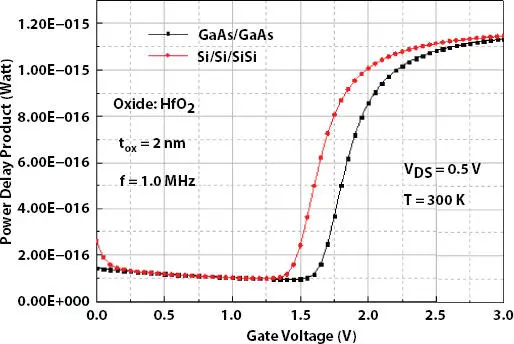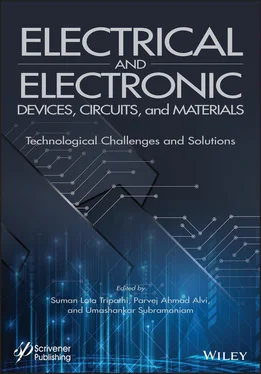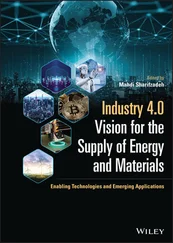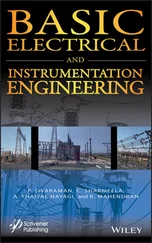
Figure 2.16 Sensitivity of power delay product (PDP) with applied gate voltage (V GS) and comparison between double gate hetero and homo structure DG -TFET.
In conclusion, the present chapter summarizes the obtained results by popular device analysis technique, modeling and simulation of DG -TFET. For obtaining excellent performance of DG -TFET, the gate dielectric and band engineering technique has been implemented successfully and its effect on the DC, CV and switching performance have been investigated thoroughly. The DG - TFET shows the excellent device and circuit design characteristics in term of switching current (I ON) ~ 4.00 × 10 -6A/µm, leakage current (I OFF) ~ 1.00 × 10 -20A/ µm, steep subthreshold swing (SS) ~34.25 mV/decade, I ON/I OFF~ 10 14for HfO 2(k ≈ 25) gate dielectric materials. The bandgap engineering approach in the conventional DG - TFET with high - k gate dielectrics is useful for reduction of ambipolar current (I amb). During investigation, the suppression of the ambipolar current I amb~10 8A/µm times has been observed. The TFET-based design with hetero DG - TFET shows better transconductance efficiency (g m/I DS) than homo DG - TFET. The maximum cut-off frequency ( f T) ~ 0.65 GHz and GBW ~ 0.66 GHz have obtained the goal of the RF applications. The hetero DG -TFET shows a smaller power delay product (PDP) ~1.1×10 -15watt and delay time (t d) order of pico range (~ 600 Picoseconds). The obtained results during investigation for the proposed design supposed to the usability in the field of digital and analog applications in terms of circuit and system design with ultra-low-power applications.
Special thanks to Prof. S. C. Mishra, Indian Institute of Technology Kanpur, India, for providing us with valuable suggestions and comments.
1. T. Masuhara, IEEE Asian Solid-State Circuits Conference, Jeju, pp. 5-8, 2011 .
2. R. -. Yan, A. Ourmazd and K. F. Lee, IEEE Transactions on Electron Devices , Vol. 39, pp. 1704 - 1710, 1992.
3. A. M. Ionescu, IEEE International Electron Devices Meeting (IEDM) , San Francisco, CA, pp. 1.2.1-1.2.8, 2017 .
4. U. E. Avci, D. H. Morris and I. A. Young, IEEE Journal of the Electron Devices Society , Vol. 3, pp. 88-95, 2015.
5. J. W. Lee and W. Y. Choi, IEEE Access , Vol. 8, pp. 67617-67624, 2020.
6. W. Y. Choi, B. Park, J. D. Lee and T. K. Liu, IEEE Electron Device Letters , Vol. 28, pp. 743-745, 2007.
7. K. Narimani et al ., Joint International EUROSOI Workshop and International Conference on Ultimate Integration on Silicon (EUROSOI-ULIS) , Athens, pp. 75-78, 2017.
8. W. Cao, D. Sarkar, Y. Khatami, J. Kang, J. and K. Banerjee, AIP Advances , Vol 4, pp. 067141, 2014.
9. S. Yang, H. Lv, B. Lu, S. Yan and Y. Zhang, IEEE Access , Vol. 8, pp. 23559-23567, 2020.
10. W. Li and J. C. S. Woo, IEEE Transactions on Electron Devices , Vol. 67, pp. 1480-1484, 2020.
11. N. Guenifi, S.B. Rahi, and T. Ghodbane, Materials Focus , Vol. 7, pp. 866-872, 2018.
12. S.B. Rahi, B. Ghosh, RSC Advances , Vol. 5, pp. 54544-54550, 2015.
13. A. C. Seabaugh and Q. Zhang, Proceedings of the IEEE , Vol. 98, pp. 2095-2110, 2010.
14. K. M. Choi and W. Y. Choi, IEEE Electron Device Letters , Vol. 34, pp. 942-944, 2013.
15. S.B. Rahi, P. Asthana & S. Gupta, Journal of Computational Electronics , Vol. 16, pp. 30-38, 2017.
16. S.B. Rahi, B. Ghosh and B. Bishnoi, Journal of Semiconductors , Vol.36, pp: 034002_1-034002_5, 2015.
17. D. Sarkar, X. Xie, W. Liu, et al. , Nature , Vol. 526, pp. 91–95, 2015.
18. A.M. Ionescu, and H. Riel, Nature , Vol. 479, pp.329-337, 2011.
19. E.H. Toh, G.H.Wang, G. Samudra, and Y.C.Yeo, Applied Physics Letters , Vol. 90, pp. 263507e1-263507-3,2007.
20. A. C. Seabaugh and Q. Zhang, Proceedings of the IEEE , Vol. 98, pp. 2095-2110, 2010.
21. I. A. Pindoo, S. K. Sinha and S. L. Tripathi, International Conference on Cutting-edge Technologies in Engineering (ICon-CuTE), Uttar Pradesh, India , pp. 28-32, 2019.
22. H. Liu, S. Datta and V. Narayanan, International Symposium on Low Power Electronics and Design (ISLPED), Beijing , pp. 145-150, 2013.
23. W. Cheng et al ., IEEE Journal of the Electron Devices Society , Vol. 8, pp. 336-340, 2020.
24. A. S. Verhulst, D. Leonelli, R. Rooyackers and G. Groeseneken, Journal of Applied Physics , Vol. 110, pp. 024510, 2011.
25. B. Sedighi, X. S. Hu, H. Liu, J. J. Nahas and M. Niemier, IEEE Transactions on Circuits and Systems , Vol. 62, pp. 39-48, 2015.
26. K. Boucart and A. M. Ionescu, IEEE Transactions on Electron Devices, Vol. 54, pp. 1725-1733, July 2007.
27. S. Datta, H. Liu, and V. Narayanan, Microelectronics Reliability , Vol. 54, pp. 861-874, 2014.
28. X. Wang, Z. Tang, L. Cao, J. Li and Y. Liu, IEEE Access , Vol. 7, pp. 100675-100683, 2019.
29. E. O. Kane, Journal of Physics and Chemistry of Solids , Vol. 12, pp. 181–188, 1959.
30. W. G. Vandenberghe, A. S. Verhulst, G. Groeseneken, B. Soree and W. Magnus, MELECON 2008 - The 14th IEEE Mediterranean Electro technical Conference , Ajaccio, 2008, pp. 923-928.
* Corresponding author : guenifi_2000@yahoo.fr
3
Polymer Electrolytes: Development and Supercapacitor Application
Anil Arya1*, Anurag Gaur2 and A. L. Sharma1
1Department of Physics, Central University of Punjab, Bathinda, Punjab, India
2Departmet of Physics, National Institute of Technology, Kurukshetra, Haryana, India
Abstract
Due to the increasing demand for energy globally and the reduction of the traditional energy sources, the development of an efficient and sustainable energy source has grabbed the attention of researchers. So, supercapacitor (SC) is a crucial energy storage device that has gained attention in the energy sector. One important part of any SC cell is the electrolyte. The electrolyte plays an important role in the ion migration in the device between electrodes. Hence, polymer electrolytes are fascinating candidates and fulfil the need due to better mechanical properties and ion dynamics. Consequently, the present chapter will start with a brief introduction to supercapacitors, followed by characteristics of electrolyte, types and modification strategies for the electrolyte. Further, the important preparation techniques and advanced characterization techniques are briefed. Finally, some important developments made using the polymer electrolytes for SC cell are presented (publications and patents).
Keywords:Polymer electrolytes, energy storage devices, supercapacitor, hybrid capacitor, energy density etc.
The global energy crisis and depletion of traditional sources of energy (coal, fuel), has captured the attention of the scientific community and is the biggest global challenge that needs to be resolved in the 21st century. It is a top priority to switch from non-renewable to renewable sources of energy (hydro, wind, solar) which are superior in terms of efficiency, sustainability, and long service life. Energy from various sources needs to be stored somewhere and used on-demand. Two important emerging technological candidates are battery and supercapacitor. The task for the scientific community is towards up-gradation of electrochemical energy storage devices (supercapacitors, batteries) and making them efficient to reduce dependency on traditional sources of energy. From traditional capacitors to the supercapacitors available nowadays, the battery is a crucial energy storage device. Among them, Supercapacitors (SC) emerged as a promising alternative to a traditional capacitor having a low capacity and the battery having low power density [1, 2]. The low energy density in SC is due to charge storage limited to the surface, so this is an important parameter that is the focus of research. The energy density of SC is related to the specific capacitance of the electrode materials and the voltage window of the cell. The voltage window of the cell is linked to the electrochemical voltage stability window of the electrolyte used. The strategy has been built to develop novel electrodes with high surface area, high porosity and high effective interaction area for charge storage. Along with this, different charge storage mechanisms have been developed to enhance the overall cell capacitance by tailoring the cell configuration (symmetric/asymmetric/hybrid) and electrode material (carbon/metal oxide/sulfide) [3–5]. In conclusion, research is focused on the development of novel electrode and electrolyte materials as well as tailoring of the existing materials to enhance the electrochemical performance of the SC cell.
Читать дальше













